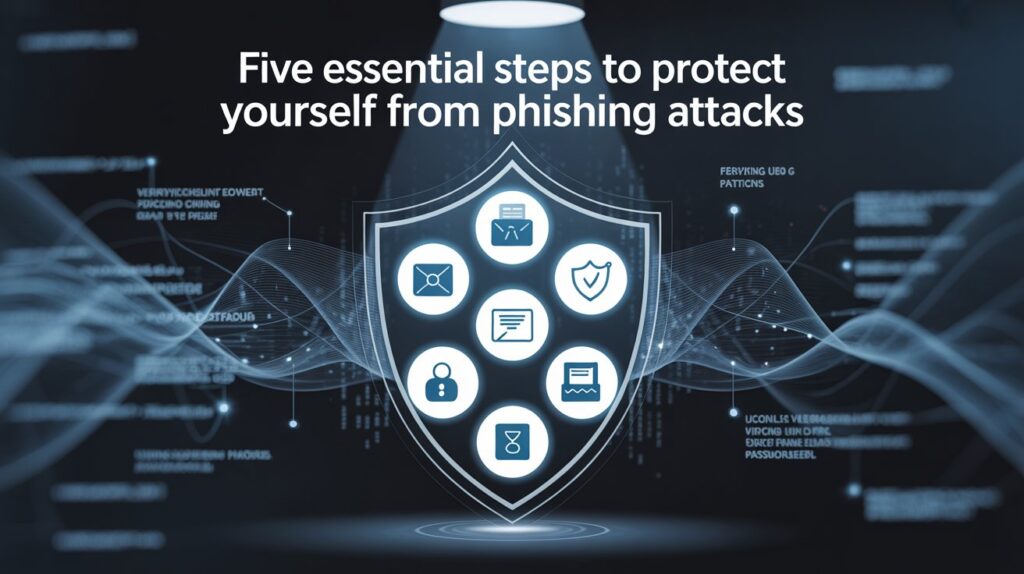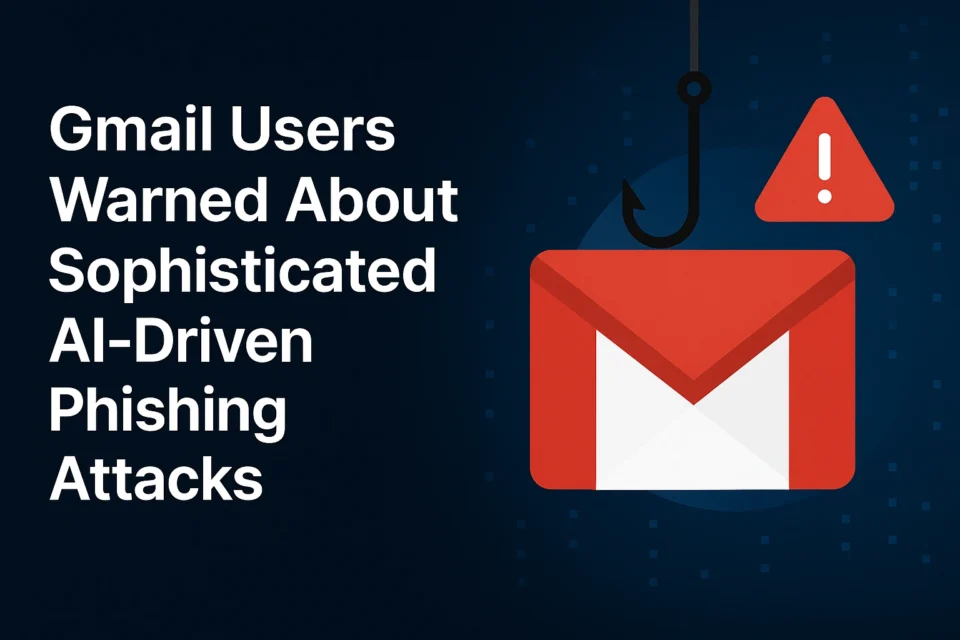Phishing attacks have long been a major cybersecurity threat, but the rise of artificial intelligence (AI) has taken these scams to a terrifying new level. Recent reports from Google’s Threat Analysis Group (TAG) and leading cybersecurity firms reveal that hackers are now leveraging AI to craft highly convincing phishing emails, making them harder to detect than ever before.
Gmail, with over 1.8 billion users worldwide, is a prime target for these AI-driven attacks. Cybercriminals are using generative AI tools like ChatGPT to automate personalized scams, mimic trusted contacts, and bypass traditional security filters. This alarming trend means that even tech-savvy users could fall victim to these sophisticated schemes.
Let’s find out how AI is supercharging phishing attacks, why Gmail users warned about sophisticated ai-driven phishing attacks and how you can protect yourself.
The New Face of Phishing: AI’s Dark Side
Phishing attacks are nothing new, but AI has elevated them to an alarming level of sophistication. Unlike traditional scams relying on poorly worded emails or obvious typos, AI-powered phishing leverages advanced language models to craft messages that are nearly indistinguishable from legitimate communications. These emails mimic Google’s branding, tone, and formatting with chilling accuracy, often addressing users by name and referencing specific account details.
The FBI has reported a 49% surge in phishing attempts evading conventional filters since 2022, with AI-generated attacks comprising nearly 5% of all phishing incidents in 2024. According to the Hoxhunt Phishing Trends Report, 96% of organizations faced phishing attempts last year, with many falling victim to AI-driven schemes. These attacks exploit techniques like Open Graph Spoofing, where metadata is manipulated to display fake website previews, tricking users into believing they’re interacting with Google’s official domain.
The stakes are high. A single successful phishing attempt can lead to stolen credentials, financial fraud, or unauthorized access to linked Google services like Drive, Photos, or Pay. High-profile cases, such as the near-compromise of Hack Club founder Zach Latta, highlight the scams’ potency. Latta received a convincing call from a spoofed Google number, followed by an email urging him to enter a recovery code—a tactic that could have handed attackers full control of his account.
Do you know: What Is Email Spoofing And How To Avoid It
How AI is Revolutionizing Phishing Attacks?
Traditional phishing emails were often easy to spot due to poor grammar, generic greetings, or obvious fake links. However, AI has changed the game by enabling:
1. Hyper-Personalized Scams
- AI analyzes public data (social media, leaked databases) to craft emails that sound like they’re from colleagues, banks, or even friends.
- Attackers use natural language generation (NLG) to mimic writing styles, making messages appear legitimate.
2. Automated Social Engineering at Scale
- AI chatbots can generate thousands of unique phishing emails in minutes, each tailored to different targets.
- Tools like WormGPT (a malicious ChatGPT variant) allow hackers to automate convincing business email compromise (BEC) scams.
3. Deepfake Audio & Impersonation
- Some attacks now include AI-generated voice calls pretending to be CEOs or IT support to trick victims into sharing credentials.
Why Gmail is a Prime Target for Phishing Attacks?
Google’s email service is a favorite among cybercriminals because:
✔ Massive User Base – More targets mean higher success rates.
✔ Integration with Google Workspace – Phishers exploit trust in Google Docs, Drive, and Calendar invites.
✔ AI-Powered Evasion – Attackers use AI to bypass Gmail’s spam filters by constantly altering email patterns.
Common AI-Driven Gmail Scams
- Fake “Security Alert” Emails – Urging users to click a link to “secure their account.”
- AI-Generated “Urgent” Requests – Mimicking bosses or vendors asking for wire transfers.
- Fake Google Drive Links – Malicious files disguised as shared documents.
How to Spot AI-Generated Phishing Emails?
While AI makes scams harder to detect, there are still red flags:
- Too Perfect Language – Unusually polished or slightly unnatural phrasing.
- Urgent or Threatening Tone – “Your account will be suspended in 24 hours!”
- Mismatched Sender Addresses – Hover over links to check URLs before clicking.
- Unusual Requests – Be wary of unexpected password resets or payment demands.
Also know: Human Factor: The Primary Risk in Cybersecurity for Industries
Five Essential Steps to Protect Yourself from Phishing Attacks

While Google’s defenses are formidable, user vigilance is critical to staying safe. Here are five actionable steps to protect your Gmail account from AI-driven phishing attacks:
- Enable Multi-Factor Authentication (MFA): Activate MFA in your Google Account settings, opting for Google Authenticator or a physical security key over SMS-based 2FA, which can be intercepted. MFA adds a critical barrier, requiring a second form of verification even if attackers steal your password.
- Verify Sender Addresses and Links: Always check the sender’s email address for subtle discrepancies (e.g., “accounts.googlee.com” instead of “accounts.google.com”). Hover over links without clicking to inspect the URL, ensuring it leads to a legitimate Google domain.
- Monitor Account Activity: Regularly check your Gmail “Recent Activity” log (accessible via account.google.com) for unfamiliar logins or devices. If you spot suspicious activity, change your password immediately and enable recovery options.
- Use a Password Manager with URL Matching: Employ a password manager like Bitwarden or 1Password with URL-matching features to ensure credentials are only entered on legitimate Google domains, reducing the risk of phishing site compromises.
- Enroll in the Advanced Protection Program: If you’re a high-risk user—such as a business owner, journalist, or public figure—enroll in Google’s Advanced Protection Program. It requires physical security keys and restricts third-party app access, offering robust protection against targeted attacks.
Expert Insights: The Growing Threat
“AI has lowered the barrier to entry for cybercriminals,” says Jane Smith, a Threat Intelligence Analyst at Palo Alto Networks. “Now, even low-skilled hackers can launch highly effective phishing campaigns with just a few AI prompts.”
Google has acknowledged the challenge, rolling out AI-enhanced security features in Gmail, but experts warn that user vigilance remains the best defense.
The Future of Phishing: What Lies Ahead
As AI technology advances, so too will the tactics of cybercriminals. Experts predict that by 2026, AI-driven phishing attacks could account for over 10% of all cyber threats, driven by improvements in generative AI models. These models can create not only hyper-realistic emails but also dynamic phishing websites that adapt in real-time to user inputs, making detection even harder. Additionally, the rise of multimodal AI—capable of generating text, images, and audio—could lead to phishing campaigns that combine convincing emails with fake video messages impersonating Google support staff.
The integration of stolen data from large-scale breaches, such as those affecting social media platforms, will further enhance personalization. Attackers may reference recent Google searches, YouTube watch history, or even location data gleaned from Google Maps to craft eerily specific phishing lures. Meanwhile, the growing use of AI voice cloning could make robocalls indistinguishable from human interactions, increasing the likelihood of success.
On the defensive side, Google is investing heavily in AI to counter these threats. Next-generation spam filters, powered by advanced machine learning, are being trained to detect subtle patterns in AI-generated content, such as unnatural language cadences or metadata inconsistencies. However, the cat-and-mouse game between attackers and defenders will persist, making user education a critical component of cybersecurity.
Conclusion: Stay Alert, Stay Safe
AI-driven phishing is evolving rapidly, and Gmail users must adapt. By recognizing the signs of AI-generated scams and implementing strong security habits, you can significantly reduce your risk.
Community-driven efforts also play a role. Online forums like Reddit’s r/cybersecurity or X discussions tagged with #CyberSec often share real-time warnings about new phishing campaigns. Engaging with these communities can provide early alerts and practical tips from fellow users.
Have you encountered an AI-powered phishing attempt? Share your experience in the comments below—awareness is the first step toward safety.
FAQs: AI-Driven Phishing Attacks on Gmail Users
AI-driven phishing attacks use advanced artificial intelligence to create convincing emails, calls, or robocalls that mimic Google’s branding, tricking users into sharing login details or clicking malicious links.
Check the sender’s email for subtle errors (e.g., “googlee.com” vs. “google.com”), hover over links to verify URLs, and be wary of urgent requests for recovery codes or personal information.
AI crafts highly personalized, realistic messages using data from social media or breaches, bypassing traditional spam filters with techniques like metadata spoofing.
Don’t click links or share codes. Verify the sender’s domain, contact Google directly via official channels, and report the attempt through Gmail’s “Report Phishing” feature.
Enable multi-factor authentication (MFA), use Google Authenticator or a security key, monitor “Recent Activity” in your account, and consider Google’s Advanced Protection Program.
Google uses AI-powered spam filters to block 99.9% of phishing emails, offers Safe Browsing, passkeys, and the Advanced Protection Program, but user vigilance remains key.


